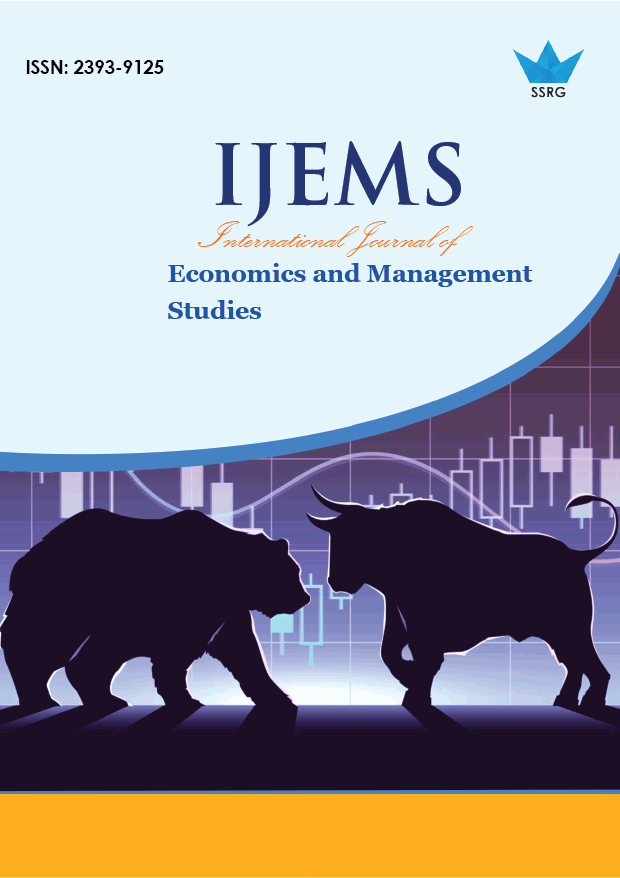Investigating Adulteration in Mustard Oil: Stakeholder Perspectives and Policy Challenges in India

| International Journal of Economics and Management Studies |
| © 2025 by SSRG - IJEMS Journal |
| Volume 12 Issue 6 |
| Year of Publication : 2025 |
| Authors : Abhishek Khemka |
How to Cite?
Abhishek Khemka, "Investigating Adulteration in Mustard Oil: Stakeholder Perspectives and Policy Challenges in India," SSRG International Journal of Economics and Management Studies, vol. 12, no. 6, pp. 61-67, 2025. Crossref, https://doi.org/10.14445/23939125/IJEMS-V12I6P106
Abstract:
Adulteration is the process of mixing cheaper, low-quality oil with pure edible oil. A primary survey indicated the main issues involved in mustard oil adulteration. Addressing this issue requires a concerted effort by all stakeholders at various levels. A primary survey indicated the main issues involved in mustard oil adulteration. Addressing this issue requires a concerted effort by all stakeholders at multiple levels. Adulteration of edible oils is a serious issue that plagues the Indian economy. The problems extend from domestic production to the almost no-tariff import of the product. Due to the ever-increasing demand, adulteration and imports become attractive propositions. The primary reasons for adulteration in edible oil are a cheaper production cost, and increasing domestic production of edible oil seeds has also positively correlated with edible oil production in India. The lack of self-sufficiency since the 1900s shows a lack of progression, and so the continued long-driven slow growth in this area. The three main oils that are used for adulteration are palm oil, vanaspati oil, and argemone oil. The harmful effects of adulteration, as seen by the dropsy case, have also been highlighted, which shows a negative impact that adulteration may have on human health. A primary survey indicated the main issues involved in mustard oil adulteration. Addressing this issue requires a concerted effort by all stakeholders at various levels, including retailers, suppliers of oilseed, and farmers from different states of Punjab, Rajasthan, and Bihar.
Keywords:
Adulteration, Dropsy Effect, FSSAI, Mustard Oil, Oilseed Production.
References:
[1] Ministry of Consumer Affairs, Food and Public Distribution, Government of India, Edible Oil Scenario, 2025. [Online]. Available: https://dfpd.gov.in/edible-oil-scenario/en
[2] Neelam Patel, Harshika Choudhary, and Shri Sambuddha Goswami, Pathways and Strategy for Accelerating Growth in Edible Oil towards the Goal of Atmanirbharta, 2024. [Online]. Available: https://www.niti.gov.in/sites/default/files/2024-08/Pathways_and_Strategy_for_Accelerating_Growth_in_Edible_Oil_towards_Goal_of_Atmanirbharta_August%2028_Final_compressed.pdf
[3] Climate Change Impacts on Agriculture and Food Supply | US EPA, US EPA, 2025. [Online]. Available: https://www.epa.gov/climateimpacts/climate-change-impacts-agriculture-and-food-supply
[4] Official Website of Department of Food and Public Distribution, Ministry of Consumer Affairs, Food and Public Distribution, Government of India. [Online]. Available: https://dfpd.gov.in
[5] Food Safety and Standards Authority of India and R. Sharma, FSSAI Tights Vigil Against Adulteration in Edible Oils Trans-Fatty Acids and Sale of Multi Source Edible Oils without Proper Labelling, FSSAI, 2022. [Online]. Available: https://www.fssai.gov.in/upload/press_release/2022/08/62fcb62aa2949Press_Release_Edible_Oil_17_08_2022.pdf
[6] Mysha Momtaz, Saniya Yesmin Bubli, and Mohidus Samad Khan, “Mechanisms and Health Aspects of Food Adulteration: A Comprehensive Review,” Foods, vol. 12, no. 1, pp. 1-25, 2023.
[CrossRef] [Google Scholar] [Publisher Link]
[7] Bhattacharya, Adulteration and the Medical Market, Disparate Remedies - NCBI Bookshelf, 2023. [Online]. Available: https://www.ncbi.nlm.nih.gov/books/NBK592783/
[8] India, The Prevention of Food Adulteration Act & Rules, 2004. [Online]. Available:https://www.fssai.gov.in/upload/uploadfiles/files/pfa-acts-and-rules.pdf
[9] Afrin Begum, and Buddhi Prakash Jain, “Adulteration in Edible Oil (Mustard Oil) and Ghee; Detection and Their Effects on Human Health,” International Journal of Biochemistry and Molecular Biology, vol. 15, no. 6, pp. 141-148, 2024.
[CrossRef] [Google Scholar] [Publisher Link]
[10] Ministry of Agriculture & Farmers Welfare, Government of India, Annual Report 2023–24, New Delhi, India: Ministry of Agriculture & Farmers Welfare, 2024. [Online]. Available: https://www.agriwelfare.gov.in/Documents/AR_English_2023_24.pdf
[11] Vishwa Mohan, Rabi Crop Acreage Records Jump in 2024-25 But Farmers Continue to Pick Wheat Over Oilseeds, The Times of India, 2025. [Online]. Available: https://timesofindia.indiatimes.com/india/overall-acreage-of-rabi-crops-increases-in-2024-25-but-oilseeds-fail-to-get-desired-attention/articleshow/117695472.cms
[12] Arvind Kumar, O.P. Premi and and Lijo Thomas, “Rapeseed-Mustard cultivation in India - An Overview,” Global Council for Innovation in Rapeseed and Canola, 2008.
[Google Scholar] [Publisher Link]
[13] Shubhi Patel et al., “Passive Adaptation to Climate Change among Indian Farmers,” Ecological Indicators, vol. 154, pp. 1-10, 2023.
[CrossRef] [Google Scholar] [Publisher Link]
[14] B.M. Vyas, and Manu Kaushik, How India was Stripped of its Atmanirbharta in the Edible Oil Industry, The Wire, 2020. [Online]. Available: https://thewire.in/political-economy/india-edible-oil-self-sufficiency
[15] Rinchen Norbu Wangchuk, Operation Golden Flow: India’s Atmanirbhar Success Story That Gave Birth to ‘Dhara’, The Better India, 2020. [Online]. Available: https://thebetterindia.com/244400/operation-golden-flow-indias-atmanirbhar-success-story-that-gave-birth-to-dhara/
[16] Laxmikant Ramkumarsingh Tomar et al., “Epidemic Dropsy 2013: Case Series,” Tropical Doctor, vol. 45, no. 2, pp. 1-3, 2014.
[CrossRef] [Publisher Link]
[17] Commission for Agricultural Costs and Prices, Price Policy for Kharif Crops: The Marketing Season 2007-08, Ministry of Agriculture, Government of India, New Delhi, India, 2007. [Online]. Available: https://cacp.da.gov.in/ViewReports.aspx?Input=2&KeyId=460&PageId=40
[18] Alisa G. Woods, and Costel C. Darie, Advancements of Mass Spectrometry in Biomedical Research, 1st ed., Springer International, pp. 1-600, 2019.
[CrossRef] [Google Scholar] [Publisher Link]
[19] P.K. Rai, All India Coordinated Research Project on Rapeseed-Mustard, and Government of India, Project Coordinator’s Report (2020-21). [Online]. Available: https://www.drmr.res.in/aicrp2021/DRMR-PC-Report-2021.pdf

 10.14445/23939125/IJEMS-V12I6P106
10.14445/23939125/IJEMS-V12I6P106